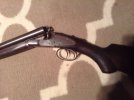This thread is about the rejuvenation, preservation, and repair of his LC Smith 20ga double. Field grade, 25” factory (rare length) barrels w/ full/full chokes. Curtis style forend catch.
Issues: Broken firing pin, broken top lever spring, thin barrel bluing, exterior putting on barrels, stock finish blemishes.
Objectives: return to shootable condition by repairing broken parts, refresh original stock finish and apply additive hand rubbed oil coats to protect it for future use, strike out pitting, polish to 320 grit field grade sheen, and slow rust blue barrels.
[mention]NCFubar [/mention]
Issues: Broken firing pin, broken top lever spring, thin barrel bluing, exterior putting on barrels, stock finish blemishes.
Objectives: return to shootable condition by repairing broken parts, refresh original stock finish and apply additive hand rubbed oil coats to protect it for future use, strike out pitting, polish to 320 grit field grade sheen, and slow rust blue barrels.
[mention]NCFubar [/mention]
























































